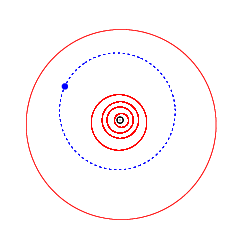Astronomy:9991 Anežka
 Orbit comparison of 9991 Anežka (blue), inner planets (red) and Jupiter (outermost) | |
| Discovery [1] | |
|---|---|
| Discovered by | Z. Moravec |
| Discovery site | Kleť Obs. |
| Discovery date | 5 October 1997 |
| Designations | |
| (9991) Anezka | |
| Named after | Anežka Moravcová (discoverer's grandmother)[2] |
| 1997 TY7 · 1977 DX9 1983 GV1 · 1994 BZ | |
| Minor planet category | main-belt · Themis [3] |
| Orbital characteristics [1] | |
| Epoch 4 September 2017 (JD 2458000.5) | |
| Uncertainty parameter 0 | |
| Observation arc | 40.19 yr (14,681 days) |
| |{{{apsis}}}|helion}} | 3.7082 AU |
| |{{{apsis}}}|helion}} | 2.6975 AU |
| 3.2028 AU | |
| Eccentricity | 0.1578 |
| Orbital period | 5.73 yr (2,094 days) |
| Mean anomaly | 356.19° |
| Mean motion | 0° 10m 19.2s / day |
| Inclination | 2.1773° |
| Longitude of ascending node | 80.608° |
| 115.62° | |
| Physical characteristics | |
| Dimensions | 7.92 km (calculated)[3] 12.293±0.294 km[4][5] |
| Rotation period | 4.4692±0.0019 h[6] |
| Geometric albedo | 0.08 (assumed)[3] 0.097±0.013[4][5] |
| C [3] | |
| Absolute magnitude (H) | 12.7[4] · 13.3[1] · 13.415±0.003 (R)[6] · 13.86[3] · 13.89±0.32[7] |
9991 Anežka, provisional designation 1997 TY7, is a carbonaceous Themistian asteroid from the outer region of the asteroid belt, approximately 10 kilometers in diameter.
The asteroid was discovered on 5 October 1997, by Czech astronomer Zdeněk Moravec at the South Bohemian Kleť Observatory in the Czech Republic.[8] It was named after the discoverer's grandmother, Anežka Moravcová.[2]
Orbit and classification
Anežka is a carbonaceous asteroid and member of the Themis family, a dynamical family of outer main-belt asteroids with nearly coplanar ecliptical orbits. It orbits the Sun at a distance of 2.7–3.7 AU once every 5 years and 9 months (2,094 days). Its orbit has an eccentricity of 0.16 and an inclination of 2° with respect to the ecliptic.[1] It was first identified as 1977 DX9 at the Japanese Kiso Observatory in 1977, extending the body's observation arc by 20 years prior to its discovery.[8]
Physical characteristics
Rotation period
A rotational lightcurve for this asteroid was obtained from photometric observations at the Palomar Transient Factory in December 2012. It gave it a rotation period of 4.4692±0.0019 hours with a brightness variation of 0.24 in magnitude ({{{1}}}).[6]
Diameter and albedo
According to the survey carried out by the NEOWISE mission of NASA's Wide-field Infrared Survey Explorer, the asteroid measures 12.3 kilometers in diameter and its surface has an albedo of 0.097,[4] while the Collaborative Asteroid Lightcurve Link assumes an albedo of 0.08 and calculates a diameter of 7.9 kilometers.[3]
Naming
This minor planet was named after the discoverer's grandmother, Anežka Moravcová (b 1924), on her 75th birthday.[2] The official naming citation was published by the Minor Planet Center on 4 May 1999 (M.P.C. 34632).[9]
References
- ↑ Jump up to: 1.0 1.1 1.2 1.3 "JPL Small-Body Database Browser: 9991 Anezka (1997 TY7)". Jet Propulsion Laboratory. https://ssd.jpl.nasa.gov/sbdb.cgi?sstr=2009991.
- ↑ Jump up to: 2.0 2.1 2.2 Schmadel, Lutz D. (2007). "(9991) Anežka". Dictionary of Minor Planet Names – (9991) Anežka. Springer Berlin Heidelberg. p. 716. doi:10.1007/978-3-540-29925-7_7780. ISBN 978-3-540-00238-3.
- ↑ Jump up to: 3.0 3.1 3.2 3.3 3.4 3.5 "LCDB Data for (9991) Anezka". Asteroid Lightcurve Database (LCDB). http://www.minorplanet.info/PHP/generateOneAsteroidInfo.php?AstInfo=9991%7CAnezka.
- ↑ Jump up to: 4.0 4.1 4.2 4.3 Mainzer, A.; Grav, T.; Masiero, J.; Hand, E.; Bauer, J.; Tholen, D. et al. (November 2011). "NEOWISE Studies of Spectrophotometrically Classified Asteroids: Preliminary Results". The Astrophysical Journal 741 (2): 25. doi:10.1088/0004-637X/741/2/90. Bibcode: 2011ApJ...741...90M. http://adsabs.harvard.edu/cgi-bin/bib_query?bibcode=2011ApJ...741...90M. Retrieved 1 August 2016.
- ↑ Jump up to: 5.0 5.1 Masiero, Joseph R.; Mainzer, A. K.; Grav, T.; Bauer, J. M.; Cutri, R. M.; Dailey, J. et al. (November 2011). "Main Belt Asteroids with WISE/NEOWISE. I. Preliminary Albedos and Diameters". The Astrophysical Journal 741 (2): 20. doi:10.1088/0004-637X/741/2/68. Bibcode: 2011ApJ...741...68M. http://adsabs.harvard.edu/cgi-bin/bib_query?bibcode=2011ApJ...741...68M. Retrieved 4 December 2016.
- ↑ Jump up to: 6.0 6.1 6.2 Waszczak, Adam; Chang, Chan-Kao; Ofek, Eran O.; Laher, Russ; Masci, Frank; Levitan, David et al. (September 2015). "Asteroid Light Curves from the Palomar Transient Factory Survey: Rotation Periods and Phase Functions from Sparse Photometry". The Astronomical Journal 150 (3): 35. doi:10.1088/0004-6256/150/3/75. Bibcode: 2015AJ....150...75W. http://adsabs.harvard.edu/cgi-bin/bib_query?bibcode=2015AJ....150...75W. Retrieved 1 January 2016.
- ↑ Veres, Peter; Jedicke, Robert; Fitzsimmons, Alan; Denneau, Larry; Granvik, Mikael; Bolin, Bryce et al. (November 2015). "Absolute magnitudes and slope parameters for 250,000 asteroids observed by Pan-STARRS PS1 - Preliminary results". Icarus 261: 34–47. doi:10.1016/j.icarus.2015.08.007. Bibcode: 2015Icar..261...34V. http://adsabs.harvard.edu/cgi-bin/bib_query?bibcode=2015Icar..261...34V. Retrieved 1 August 2016.
- ↑ Jump up to: 8.0 8.1 "9991 Anezka (1997 TY7)". Minor Planet Center. https://www.minorplanetcenter.net/db_search/show_object?object_id=9991.
- ↑ "MPC/MPO/MPS Archive". Minor Planet Center. https://www.minorplanetcenter.net/iau/ECS/MPCArchive/MPCArchive_TBL.html.
External links
- Asteroid Lightcurve Database (LCDB), query form (info )
- Dictionary of Minor Planet Names, Google books
- Asteroids and comets rotation curves, CdR – Observatoire de Genève, Raoul Behrend
- Discovery Circumstances: Numbered Minor Planets (5001)-(10000) – Minor Planet Center
- 9991 Anežka at AstDyS-2, Asteroids—Dynamic Site
- 9991 Anežka at the JPL Small-Body Database
 |

